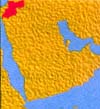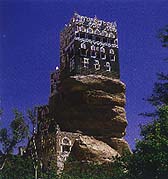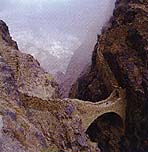Jack Jackson
Pictures by F. Jack Jackson
 Yemen, a country of extreme physical contrasts, has a lot to offer nature enthusiasts. High, rain-filled mountains (up to 3900 m) near to the Red Sea coast drop to the hot, flat Tihama plain. Scrub and gravel desert, interspersed with mountains and gorges of exposed rock, stretch to the north and east of the mountain range, abutting onto the rolling sand dunes of the Rub al-Khali. Here, the Marib area regularly sees flash floods from rain in the mountains; though these are now controlled by the new dam. Further east is the Wadi Hadramaut, a wide fertile water-course fed by run-off from the large barren plateau called the jol. The southern coast of Yemen, along the Gulf of Aden, is predominantly lava fields, interspersed with scrub areas, sand dunes and volcanic mountains.
Yemen, a country of extreme physical contrasts, has a lot to offer nature enthusiasts. High, rain-filled mountains (up to 3900 m) near to the Red Sea coast drop to the hot, flat Tihama plain. Scrub and gravel desert, interspersed with mountains and gorges of exposed rock, stretch to the north and east of the mountain range, abutting onto the rolling sand dunes of the Rub al-Khali. Here, the Marib area regularly sees flash floods from rain in the mountains; though these are now controlled by the new dam. Further east is the Wadi Hadramaut, a wide fertile water-course fed by run-off from the large barren plateau called the jol. The southern coast of Yemen, along the Gulf of Aden, is predominantly lava fields, interspersed with scrub areas, sand dunes and volcanic mountains.
 Traditional methods of land management, particularly terracing of mountainsides, have, by and large, allowed the bioheterogeneity to survive. Nevertheless, intensive hunting and the wide availability of firearms has brought pressure to bear on certain species.
Traditional methods of land management, particularly terracing of mountainsides, have, by and large, allowed the bioheterogeneity to survive. Nevertheless, intensive hunting and the wide availability of firearms has brought pressure to bear on certain species.
Animals found in Yemen include caracal, striped hyaena, foxes, hares, crested porcupines, mongoose, Indian monitors, agamid lizards, jerboa, gerbils, chameleons, scorpions, camel spiders and the occasional snake . Hamadryas baboons and rock hyrax are plentiful on the lower slopes and rock faces of the mountains facing the Red Sea. Gazelles, easily hunted by four-wheel-drive vehicles in open country, have declined in number, although a few still exist on escarpments. The leopard has also survived in remote areas.
Many small plants of interest grow in Yemen. The Rub al-Khali desert blooms after rain, acacia trees and prickly pear cactus becoming a blaze of colour when in flower. The smaller euphorbias in scrub areas and the large candelabra euphorbias from the southern slopes of the Sumara Pass to Taiz are a fine sight when in flower, as is the white lily (Crinum yemense); but the plant that really stands out is the desert rose (Adenium obesum). Unfortunately trees are rare in northern Yemen because so many have been cut down and used for firewood.
From the eco-tourism point of view, Yemen's main attraction is its birdlife, which is particularly abundant during the spring and autumn migrations. At these times thousands of raptors cross the Bab-al-Mandeb straits between Yemen and Africa, but there are also many species that use the junction of land and sea along the Red Sea coast as a flight path between Africa and Europe. Whilst running a boat in this area, I have witnessed hundreds of exhausted birds land for a rest, picked up others from the sea, and even had one fall asleep on my sunglasses, whilst I was wearing them!
Places where there is water for most of the year also support plenty of birdlife. Particularly interesting are the regular sightings of Arabian Bustards in cereal fields near to Luhayah, though, for obvious reasons, conservationists would prefer to keep the exact location secret. Arabian Bustards have also been seen south of Zebid and near Aden.
Yemen is a very attractive place for the commited eco-tourist to visit, not only because of its interesting geographical features, flora and fauna, but because the traditional lifestyle of its people has remained relatively untouched by the 20th century.
Djebel Bura/Wadi Rima
The two best areas for eco-tourism require four-wheel-drive vehicles, with an experienced driver and do not have any nearby accommodation. These are the beaches between Al Mokha and Al Hokha, and the Djebel Bura/Rima area, both are hot and humid all year round.
At any time of year, a drive along the beach between Mokha and Hokha will give you sightings of many dozens of species from waders, terns and gulls, to flamingos, ospreys, pelicans, the ubiquitous Black Kite and, with luck, a green turtle!
Djebel Bura is directly east of Hodeida, but is normally reached by a dirt track from Suknah via Mansuriya. Above Souk Al-Sabt Al-Mahrab, is a small remnant of woodland containing rare plants, some 50 species of birds, hamadryas baboons, rock hyrax, striped hyaenas, honey badgers, mongooses and genet.
Wadi Rima, descending from Djebel Rima, is southeast of Bait Al Faqih, but is best reached from Madinat Ash Shirq, which is on the new road from Ma'abar near Dhamar, on the Sana'a-Taiz road and Izzan on the Hodeida-Sana'a road. This area is more cultivated than Djebel Bura, but from 15 to 25 km south of Madinat Ash Shirq, in the areas between Souk Al Khamis and Baboon Hill, there have been sightings of all the species listed at Djebel Bura, as well as gazelles.
Wadi Hafash
Another good area, but a tough route requiring a four-wheel-drive vehicle and an experienced driver, is the wadi known locally as Hafash, which is listed under several names on maps -including Wadi Mallan and Wadi Sara. Extending from Khamis Bani Saad on the Hodeida-Manakha road, it crosses the Wadi Surdud (sometimes very deep water!) meanders through a tropical wadi for many miles and then climbs steeply out and up to Mahwit. Heavily cultivated in its lower regions, Wadi Hafash is teeming with birdlife. I have seen two metre long dark brown snakes, lots of weaver birds, Hamerkops and Grey-headed Kingfishers as well as troops of hamadryas baboons on the lower slopes as the track climbs out towards Mahwit. This wadi is regularly used as a main vehicle route, but you must always be prepared for a flash flood. Plenty of birdlife is visible along the road from Mahwit to Tawilla and on to Schibam/Kawkaban, including eagles, ravens, vultures and Tristrams Grackle. The road is currently being widened and asphalted, so one could get back to Sana'a in a very long day; but Wadi Hafash itself is a hard drive.
 Shahara Mountain
Shahara Mountain
Another difficult drive is the route to Shahara Mountain and its famous dry stone bridge. The Wadi Wa'aar below Shahara is hot, humid, scrub country populated by hornbills and Rock Partridge, whilst the route up to Shahara (not for the faint hearted!) should bring sightings of Tristrams Grackle, ravens and vultures. One should travel with a guide in this area. The famous bridge is only sunlit around 11.00 a.m.-12. 00 noon each day. You can observe vultures nesting from here.
Taiz
The best of the accessible areas near to accommodation are the Taiz sewage lagoons, where you can see many of the birds that you would expect to see on the coast. The southern side of the Sumara Pass, all the way down to Taiz is famous for its birdlife and large euphorbia trees; the areas around Ibb and Djibla being particularly good.
Wadi Dhar
Near to Sana'a, Wadi Dhar has most local species of inland birds, except vultures; but particularly interesting is the mule track from Schibam up to Kawkaban. This 45 minute walk rises nearly 923 m , with Tristrams Grackle, larks, wheatears and doves in abundance at the bottom, eagles, ravens and vultures at the top. There is also a good variety of flowering plants where water trickles through cracks in the rock.The high plateau from Kawkaban, west to Wadi Hajjar, has some hyaena.The road from Amran to Hajjar is a spectacular series of twisting bends dropping steeply through dark, sombre mountains, down from high altitude to tropical wadi and up again, with such a variety of terrain there is life of all types.
Marib dam
The new dam at Marib has a large lake that is attracting more and more bird life, there is even a recent claim that cormorants have been sighted. If you venture down the Wadi Dhana when it is flowing, during the rainy season, there are lots of birds. Make sure you have a Yemeni with you, the Bedouin people can be tetchy in this area.
Haraz Mountains
The Haraz Mountains around Manakha are spectacular terraced mountains, with fortress villages on all high points. The people are friendly, so this is a great area for walking, with lots of high altitude birds and flowers. Heavy cloud, if not rain, descends every afternoon, so aim to complete any walk by 2. 00 p.m. and carry waterproofs. These are the mountains that descend to Djebel Bura and Djebel Rima, en-route to the Tihama.
The main road from Manakha to Khamis Bani Saad drops steeply, twisting through several, narrow rock gorges, containing the Wadi Surdud. If you pass through these in the late afternoon, troops of hamadryas baboons will be jumping around over on the high cliffs. The lower part of the Wadi Surdud, either side of Khamis Bani Saad, has water all year round, supporting banana and papaya plantations, ideal places for bird-watching.
Other interesting areas
There are spec-tacular gorges between Bani Hosheish and the Fardah Pass, on the new Sana'a - Marib road and spec-tacular gorge, mountain and sand dunes by the new road being constructed between Marib and Harib and on to Timna and Nuqub. The old Marib-Harib caravan route crosses high sand dunes that continue east across the Rub al-Khali. The new road from Al Bayda to Lawdar is also spectacular, descending extremely steeply. Hot springs and crater lakes can be found all over the country. Spectacular sand dunes stretch 40 km east of Habban, and mixed sand and volcanic rock scenery from Bir Ali (ancient Qana) to Mukalla.
Socotra, in the Gulf of Aden, is now open to tourists. Because of its unique flora and fauna (see Arabian Wildlife, Vol 2, No 1), a proposal to designate Socotra as a Biosphere Reserve is being prepared by UNESCO and Yemen's Environmental Protection Council.
Useful Addresses for Yemen
Derek Harvey, Yemen Ornithological Society Coordinator, c/o Clyde Petroleum, P O Box 16133, Sana'a, Republic of Yemen.
The Discovery Guide to Yemen, by Chris Bradley, published by Immel Publishing Ltd, 20 Berkeley St, London WIX 5 AE, which will be in the shops in the autumn, will be an indispensable guide for all visitors to Yemen. Local offices of Yemenia airline also provide an unofficial tourist information service.
The following tour companies operating out of Sana'a vary considerably in the standard of service and quality of vehicles supplied:
Universal Travel and Tourism, Saif Bin Dhi Yazen Street, P O Box 10473 Sana'a. Tel 00 9671 27502
YATA (Yemen Arab Tourism Agency), Airport Road, Street No 9, Sana'a (P O Box 1153),Tel: 9671 224236; fax 9671 251597. Efficient and willing. YATA run regular bird-watching tours, mostly for German agencies.
Marib Travel and Tourism, Ali Abdul Moghni Street, PO Box 161, Sana'a. Tel 9671 272435
Al Mamoon Travel and Tourism Agency, Al Zubairy Street, P O Box 10127, Sana'a. Tel 9671 79261
Arabia Felix Tour and Travel Agency, Al Zubairy Street, P O Box 1566, Sana'a. Tel 9671 275007
Arabian Horizons, Al Qasr Street, P O Box 8665, Sana'a. Tel 9671 275414; fax 9671 275415
Bazara Travel and Tourism, Al Zubairy Street, P O Box 2616 Sana'a. Tel 9671 205865; fax 9671 209568
Yemen Tourist and Travel Agency, Al Qasr Street, P O Box 1108, San'a. Tel 9671 272914.
General Tourism Corporation, P O Box 129 Sana'a. Tel 9671 73935
Yemen Tourism Company, 65 Hadda St, P O Box 1526. Tel 9761 240372; fax 9671 244222
| Subjects | Search
Arabian Wildlife. Volume 2, Number 2